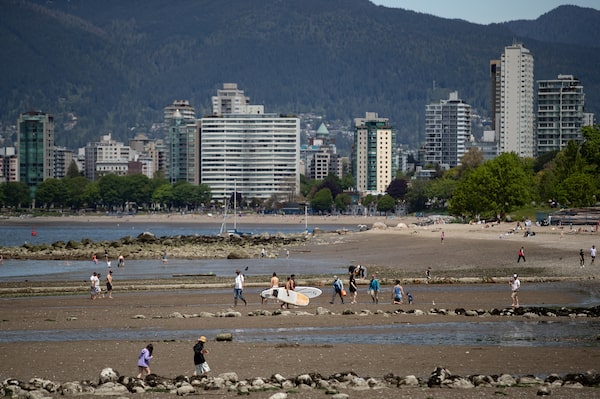
People carry paddleboards out of the water during low tide at Kitsilano Beach, in Vancouver, on Saturday, May 9, 2020. The city is moving to allow temporary restaurant patios on sidewalks and side streets.DARRYL DYCK/The Canadian Press
Vancouver will turn 50 kilometres of residential roads into “slow streets,” allowing local access only, to increase room for walking and cycling as part of a larger plan to repurpose civic spaces in an effort to reduce the spread of the novel coronavirus.
The city is also moving to allow temporary restaurant patios on sidewalks and side streets, according to a team of engineers and planners who addressed Vancouver City Council on Wednesday, but that change won’t happen for a few weeks to a month.
Restaurant and bar owners, as well as some members of council, say the city is moving too slowly to put the changes in place to ensure Vancouver can adapt.
“Time is of the essence,” said Charles Gauthier, executive director of the Downtown Vancouver Business Improvement Association that represents 7,000 businesses. “We just need to do everything possible to try to save the flavour of our city.”
John Doty, who owns the Browns Socialhouse franchise on Vancouver’s west side at 10th Avenue and Alma Street, said an expansion into outdoor space is the only way many restaurant and bar owners believe they can make it through the pandemic. Bars have been closed and restaurants have been limited to take-out only, which not all are attempting.
“It’s hard to see making it through a prolonged period without this,” Mr. Doty said.
Several councillors were frustrated that the city seemed to be moving slowly on reallocating road space, even while public opinion seems to strongly favour it and vehicle traffic is down.
Green Party Councillor Michael Wiebe questioned why no complete road closings were proposed, while his party colleague Pete Fry pointed out that 50 kilometres is only 2.5 per cent of the residential street space in the city.
“I hope you feel confident to move forward knowing you have this council’s support,” Mr. Fry said.
Many other European and American cities moved weeks ago to do either partial or complete closings of streets or squares in order to provide more room for walkers and cyclists, as commuter car traffic dropped dramatically and people became reluctant to use transit.
In many cases, they’ve said it’s not temporary because cities will need to consider new transportation methods for their residents and visitors after the pandemic.
Vancouver has essentially been in pandemic mode for two months. It saw an 80-per-cent drop in transit use and, in the early weeks of the pandemic state of emergency, about half of the normal car traffic. Cycling is also lower than it was, because schools and many workplaces are closed. But the drop has not been as significant as other modes of transportation, as people have turned to bikes for errands, commuting, fitness and recreation.
Vehicle traffic is now starting to creep up and the team’s own report said there is a concern that, as commuters return to work, “private vehicle use could increase from pre-pandemic levels.”
The city team said they’d start with a preliminary phase of road closings this month using construction-style barriers, with monitoring throughout the summer to gauge public opinion.
In the fall, they might accelerate existing plans for more greenway and public-space projects. No specific streets were named, although they said connecting with existing greenways and parks is likely.
Lisa Parker, the branch manager for street activities at the city, said a team is working on a streamlined process that would allow restaurants to create patios on sidewalks or side streets. She said temporary plazas on side streets, like the one that already exists at Main Street and 14th Avenue, are preferred.
One hurdle that still needs to be removed is provincial permission to serve liquor in the new areas.
Ms. Parker said the idea is to have a simplified and expedited process for a temporary use and assess later whether it’s working based on public feedback about the change. That’s the same for road alterations.
“If the support disappears, we would remove it right away,” said chief engineer Lon LaClaire. “But it it’s supported, we would do more and more.”
Sign up for the Coronavirus Update newsletter to read the day’s essential coronavirus news, features and explainers written by Globe reporters and editors.
 Frances Bula
Frances Bula